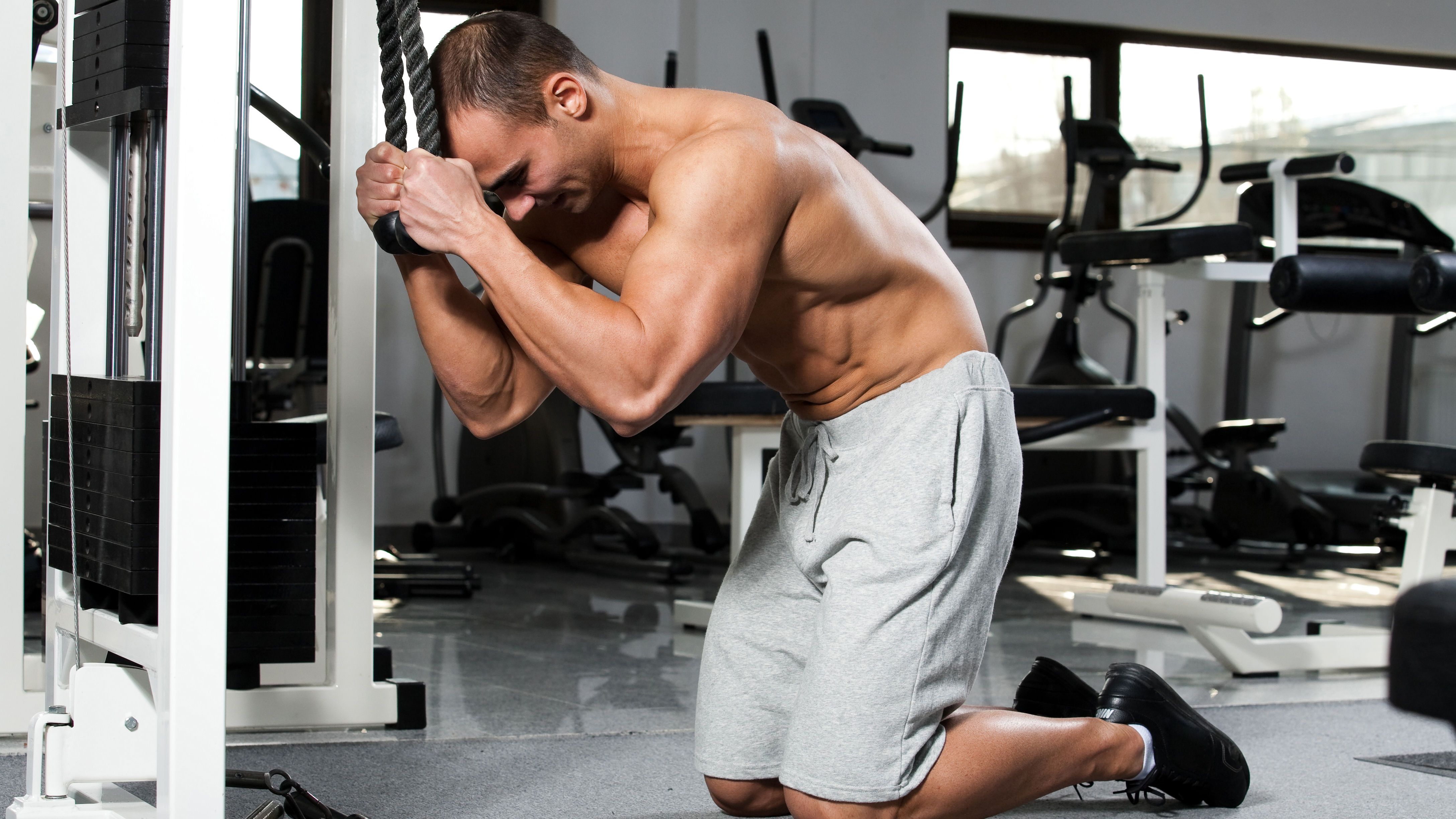How To Do The Cable Crunch
It’s easy to get this advanced abs exercise wrong. Get it right with this expert guide to correct cable crunch form

For most mere mortals, abs exercises using just your bodyweight, like sit-ups and leg raises, provide enough of a challenge to encourage muscle growth and increase strength. But some, especially those looking to take their six-pack to the next level, might need to recruit additional load to keep them growing.
Enter the cable crunch. This bodybuilding favorite uses the cable machine to make the crunch exercise much more challenging. That may sound great, but it’s not the easiest movement to master and you should exercise caution before adding it to your abs workouts.
For the dos and don’ts of this exercise we spoke with Eddie Baruta, global head of gym floor personal training at Ultimate Performance, and Cara D’Ozario, PT and owner of CGM Fitness.
How To Do The Cable Crunch
The cable crunch is not an entry-level exercise. “It’s tough to execute because you have to really anchor your legs and hips in position to effectively target your abs,” says Baruta. When practiced correctly, he says, your primary focus should be on “bringing your rib cage towards your pelvis”. Nothing more, nothing less.
The most common version of this tricky exercise is practiced facing toward the cable machine. For the facing away variation, see further down the page.
The Set-Up
Connect the triceps rope attachment to the highest pulley. Start with a light load on the weight stack as you get familiar with the movement. Kneel facing the anchor point and hold either end of the attachment by your shoulders with the rope just behind your head.
The Crunch
Lengthen your body to avoid slouching, and lock your pelvis and legs in position. Take a breath in, then slowly curl your torso forward, focusing on bringing your rib cage towards your pelvis to engage and shorten your target muscles. It’s only a small movement and you should feel the muscles working hard.
Get the Coach Newsletter
Sign up for workout ideas, training advice, reviews of the latest gear and more.
The Return
Pause for a second at the point of maximum contraction, then slowly uncurl your torso to lengthen your abs muscles until your body is fully upright, exhaling as you go. All the power and control for the exercise should stem from your core muscles rather than your legs, hip flexors or arms.
Cable Crunch Benefits
Which muscles does the cable crunch train?
As with the standard crunch, this exercise works wonders for the major muscles that make up the core.
“When performed correctly, the main muscles worked by the cable crunch are the rectus abdominis, along with the internal and external obliques,” says D’Ozario. “You might also feel your glutes and hip flexors working to stabilize your pelvis.”
Cable Crunch Risks
If the cable crunch is performed incorrectly, you’ll certainly know about it. “You’ll probably start to feel tension build up in your lower back,” says Baruta. If that’s the case, park your ego and reduce the weight on the stack so you don’t do any damage.
Common Cable Crunch Mistakes
The cable crunch exercise requires good body awareness and a solid base level of fitness to get right—or else it could easily go wrong. Here are the most common mistakes our coaches see gym-goers make.
1. Harnessing Momentum
“One of the most common mistakes I see with the cable crunch—and with most abs exercises generally—is when people misuse momentum,” says Baruta. To fix this, he urges you to think about “lengthening your abs instead of allowing the weight to pull you back up” during the eccentric phase of the lift.
Baruta also suggests matching the tempo of the concentric phase of the move with that of the eccentric section. For example, two seconds down, two seconds up. “That will teach you to properly connect with the muscles you’re trying to recruit,” he says.
Once that’s mastered, you can then slightly accelerate the concentric phase of the lift to see how that changes the emphasis of the exercise.
2. Shifting Your Hips
Another common mistake is involving your hips in the movement. “They should remain stable throughout,” says D’Ozario. Otherwise, instead of challenging your abs, you’ll end up shifting all the emphasis to your hip flexors.
Only crunch as low as you can without shifting your hips out of position, either forward or backward, and if your shoulders get anywhere near horizontal you’ve gone way too far.
3. Straining Your Neck
One other common error D’Ozario has spotted is when people strain their neck in trying to generate power to initiate the move. “As you crunch forward, keep your chin tucked in to your chest,” she recommends, just like you should with standard crunches and sit-ups.
Cable Crunch Variations
While there are many crunch variations to consider once you’ve mastered the basic crunch, here we’ll concentrate on variations of the cable crunch.
Facing-away cable crunch
A simple variation to the classic cable crunch detailed above is the facing-away version. This means the pulley is set up slightly behind you, meaning you can more easily reach full extension at the top of the exercise.
“The facing-away option is better if you can effectively anchor your legs and hips in position,” says Baruta. “You’ll then be able to shorten the muscles more effectively and feel the contraction in the right place. If the set-up is optimal, this will allow you to load the muscle where it is strongest, then allow it to drop off a little bit where you are weakest.”
Standing cable crunch
For people who struggle to kneel, you can attempt this exercise standing up. Again, you need to focus on locking your hips and pelvis in position to effectively target the abs muscles.
About Our Experts
Eddie Baruta is global head of gym floor personal training at renowned fitness business Ultimate Performance. Based in Los Angeles, Baruta is one of the most sought-after PTs in the United States, with high-profile clients including actors Dustin Hoffman, Lily Collins (Emily In Paris), Kevin McHale (Glee), Lamorne Morris (New Girl) and Glen Powell (Top Gun: Maverick).
Baruta graduated from the University of Bacău, Romania, in 2002 with a degree in Exercise Science and joined Ultimate Performance in 2010. Since then, Baruta has added qualifications including Premier Training International, Poliquin PICP 1&2 and Biosignature 1&2, Neurokinetic Therapy 1&2, Active Release Techniques 1&2 and Resistance Training Specialist (Mastery Level).
Cara D’Orazio is both a certified personal trainer and group fitness instructor. She is certified through the American College of Sports Medicine (ACSM), Aerobics and Fitness Association of America (AFAA) and International Sports and Sciences Association (ISSA).
She is proficient in barre, Pilates, TRX and kettlebell training and is a specialist in sports conditioning. She has created the LETS Werq! format. LETS stands for “lengthen, elongate, tone and stretch” and the format mixes Pilates and barre moves with low-impact cardio.

Sam Rider is an experienced freelance journalist, specialising in health, fitness and wellness. For over a decade he's reported on Olympic Games, CrossFit Games and World Cups, and quizzed luminaries of elite sport, nutrition and strength and conditioning. Sam is also a REPS level 3 qualified personal trainer, online coach and founder of Your Daily Fix. Sam is also Coach’s designated reviewer of massage guns and fitness mirrors.
- Lois MackenzieFitness writer









